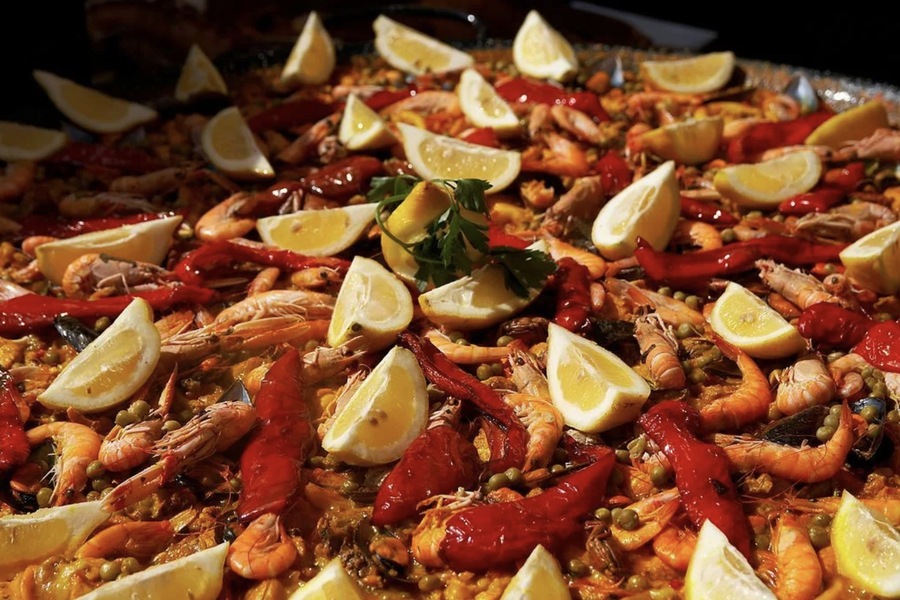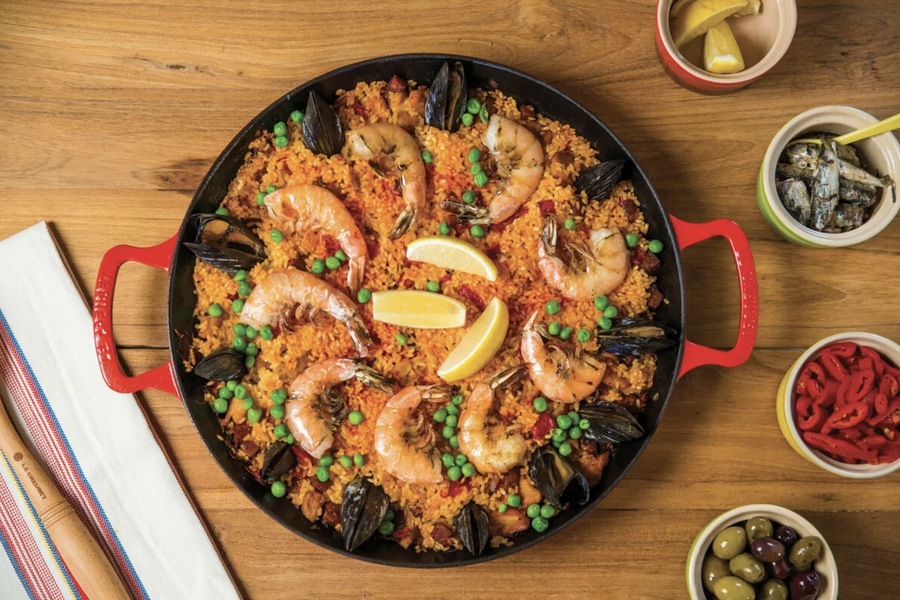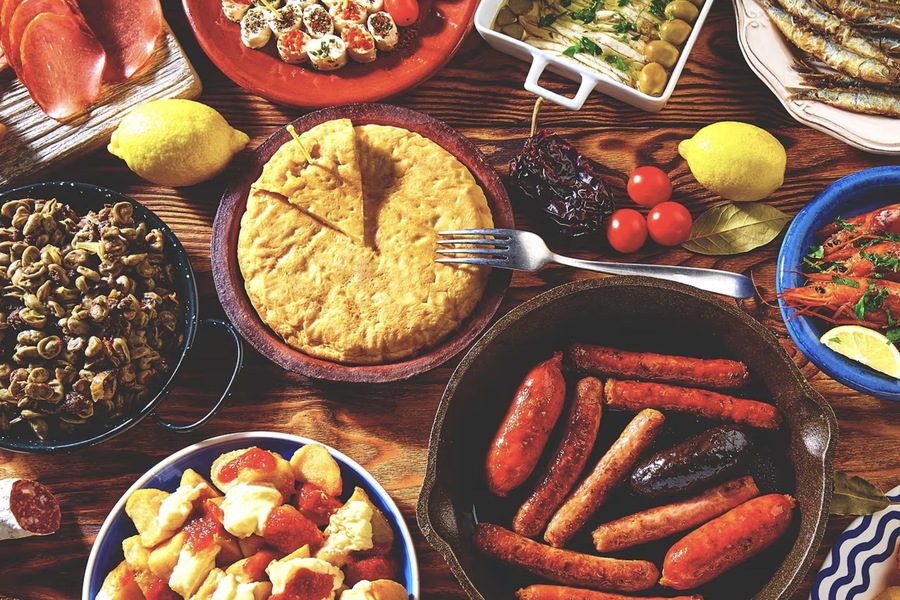Spanish cuisine is a vibrant and diverse culinary expression shaped by Spain’s rich history, geography, and culture. With distinct regional variations, fresh ingredients, and an emphasis on simplicity paired with bold flavors, it’s no wonder Spanish cuisine is celebrated around the world. Although often lumped together under a single umbrella, Spanish culinary culture is better understood as a collection of regional traditions that offer unique dishes, ingredients, and cooking techniques. From the coastal seafood dishes of Galicia to the hearty stews of Castile and the rice delicacies of Valencia, Spain’s culinary map is as diverse as its landscapes. For those looking to explore these flavors, GreatList provides a curated guide to discovering the best Spanish dining spots.
The Foundation of Spanish Cuisine
The foundation of Spanish cuisine lies in its Mediterranean roots, characterized by the abundant use of olive oil, garlic, tomatoes, and seafood. The country’s fertile land and proximity to both the Atlantic Ocean and the Mediterranean Sea make it a treasure trove of fresh ingredients. While each region boasts its own culinary identity, the following staples are shared across Spain:
Olive oil: Spain is the largest producer of olive oil in the world, and it serves as the base for many dishes.
Garlic: Whether raw, roasted, or sautéed, garlic is a critical flavor component in Spanish cuisine.
Seafood: With its expansive coastline, Spain enjoys a bounty of fresh fish, shellfish, and other seafood.
Tomatoes: A key ingredient in sauces, soups, and salads, tomatoes are ubiquitous in Spanish cooking.
Wine: Spanish wines, particularly those from La Rioja, Catalonia, and Castile, are often enjoyed alongside meals, contributing to the country’s world-renowned wine culture.

Regional Cuisines: A Journey Through Spain’s Diverse Flavors
Spain is divided into over a dozen regions, each with its own distinct culinary traditions. These regional differences are influenced by historical factors, climate, geography, and access to ingredients. The interplay of Moorish, Roman, and indigenous Spanish culinary traditions has shaped Spain’s food culture, making it a truly unique culinary destination.
1. Catalonia: A Fusion of Mediterranean Flavors
Catalonia, located in northeastern Spain, has a cuisine that reflects its proximity to both the Mediterranean and neighboring France. The influence of French cuisine is apparent, particularly in the sauces and presentation of dishes. Catalan cuisine is known for its rich, flavorful sauces and its delicate balance of sweet and savory. Some key dishes and sauces that define Catalan cooking include:
Sofrito: A fundamental sauce made from tomatoes, garlic, onions, peppers, and herbs, used as a base for many dishes.
Samfaina: A ratatouille-like dish made from tomatoes, peppers, eggplants, and zucchini, often served with fish or meat.
Ali-oli: A garlic and olive oil emulsion, similar to mayonnaise, that is commonly served with grilled meats and vegetables.
Escudella i Carn d’Olla: A traditional Catalan stew made with meat, vegetables, and pasta or rice.
The coastal influence of Catalonia can be seen in dishes such as suquet de peix (a fisherman’s seafood stew) and calçots (grilled spring onions, typically served with romesco sauce).
2. Andalusia: Home of Tapas and Gazpacho
In southern Spain, Andalusia’s cuisine is a reflection of its warm climate and Moorish influence. This region is the birthplace of tapas, a culinary tradition of small, shareable dishes served with drinks. Andalusian food often features bold flavors and spices, drawing from its Moorish past. Some of the most famous Andalusian dishes include:
Gazpacho: A cold, refreshing soup made from tomatoes, peppers, cucumbers, garlic, olive oil, and vinegar. It’s the perfect antidote to the region’s scorching summer heat.
Salmorejo: A thicker version of gazpacho, made with tomatoes and bread, often garnished with jamón and hard-boiled eggs.
Rabo de Toro: A hearty stew made from bull or oxtail, slow cooked in red wine and served with potatoes or bread.
Pescaito Frito: Fried fish, especially popular in the coastal areas, where seafood is freshly caught and fried to crispy perfection.
In addition to tapas, Andalusia is famous for sherry wine, particularly from the town of Jerez de la Frontera, which is enjoyed across the region and worldwide.
3. Valencia: The Birthplace of Paella
Perhaps the most internationally recognized Spanish dish, paella, hails from Valencia on Spain’s eastern coast. This rice-based dish, traditionally cooked in a large shallow pan over an open flame, is infused with saffron, giving it its distinctive golden hue. While there are many variations, the most traditional is paella Valenciana, made with chicken, rabbit, green beans, and sometimes snails. Coastal areas often substitute seafood for meat, creating the equally beloved paella de mariscos.
Other rice-based dishes from Valencia include:
Arroz a Banda: A dish made with rice cooked in fish stock, often served with aioli.
Fideuà: Similar to paella, but made with short noodles instead of rice, and typically featuring seafood.
Valencia’s cuisine also features a range of fresh produce, particularly oranges, for which the region is famous.
4. Galicia: The Kingdom of Seafood
In the northwestern corner of Spain lies Galicia, a region renowned for its seafood. With its rugged coastline and rich fishing tradition, Galicia’s cuisine is defined by the freshness of its ingredients. Popular dishes include:
Pulpo a la Gallega: A simple yet delicious dish of boiled octopus, seasoned with paprika, sea salt, and olive oil.
Percebes: Goose barnacles, a delicacy harvested from the rocky shores of Galicia.
Empanadas Gallegas: Savory pastries filled with fish, meat, or vegetables, commonly found at festivals and celebrations.
Caldo Gallego: A comforting soup made from greens, potatoes, and chorizo, often enjoyed in colder months.
Galicia’s food is simple, allowing the natural flavors of its seafood and produce to shine through. The region is also known for its Albariño wine, a crisp, white wine that pairs perfectly with seafood.
5. Madrid: The Heart of Spanish Cuisine
Madrid, Spain’s capital, sits in the heart of the country and boasts a cuisine that blends influences from all over the nation. While the city doesn’t have a coastal tradition, it compensates with rich, meat-heavy dishes. One of Madrid’s most iconic dishes is:
Cocido Madrileño: A hearty chickpea stew cooked with various meats (beef, pork, and chorizo) and vegetables. It’s traditionally served in three courses: first, the broth; second, the chickpeas and vegetables; and third, the meats.
Madrid is also famous for its callos a la madrileña (a tripe stew) and huevos rotos (fried eggs over potatoes and ham). Sangria, a refreshing drink made from wine, fruit, and sometimes brandy, is also popular in Madrid and throughout Spain.
Spanish Desserts: A Sweet Finale
Spanish desserts reflect the country’s diverse cultural influences, particularly from the Moors, who introduced ingredients like almonds, sugar, and cinnamon. Some of the most beloved Spanish sweets include:
Churros con Chocolate: Fried dough sticks served with a thick, rich hot chocolate for dipping, a popular breakfast or snack.
Crema Catalana: Similar to France’s crème brûlée, this dessert features a caramelized sugar top over a custard infused with lemon and cinnamon.
Tarta de Santiago: A traditional almond cake from Galicia, often decorated with a cross of Saint James.
Flan: A custard dessert topped with caramel, commonly served throughout Spain.
Polvorones and Mantecados: Shortbread-like cookies made with almonds, typically enjoyed during the Christmas season.
Spain is also famous for its marzipan, particularly from Toledo, where it is made using a centuries-old recipe of almond flour and sugar.

The Art of Tapas: A Spanish Culinary Tradition
One of the most famous Spanish dining traditions is tapas, small appetizers or snacks served alongside drinks. Tapas can range from simple dishes like olives and almonds to more elaborate fare like gambas al ajillo (garlic shrimp) and pimientos de Padrón (fried green peppers). The tapas tradition encourages socializing and sharing, making dining in Spain a communal experience.
Some of the most popular tapas dishes include:
Patatas Bravas: Fried potatoes served with a spicy tomato sauce or aioli.
Croquetas: Fried balls of béchamel sauce mixed with ham, cheese, or other ingredients.
Tortilla Española: A potato and egg omelette, often served in small slices.
Boquerones: Fresh anchovies marinated in vinegar and olive oil.
In some regions, tapas are served for free with drinks, while in others, they are ordered à la carte. Regardless, tapas are an integral part of Spanish culture and dining.
Wine and Cheese: A Perfect Pairing
No discussion of Spanish cuisine would be complete without mentioning the country’s wine and cheese traditions. Spain is one of the world’s largest wine producers, with regions like La Rioja, Ribera del Duero, and Priorat producing some of the best wines in the world. Tempranillo is the most famous Spanish grape variety, known for producing bold, full-bodied red wines. In addition to red wines, Spain is also famous for its Cava, a sparkling wine made in the Catalonia region, and sherry from Andalusia.
Spanish cheeses are equally diverse, with Manchego being the most famous. This sheep’s milk cheese from La Mancha is known for its firm texture and nutty flavor. Other notable cheeses include:
Cabrales: A blue cheese from the Asturias region.
Mahon: A cow’s milk cheese from the island of Menorca, known for its sharp, salty taste.
Idiazabal: A smoked sheep’s milk cheese from the Basque Country.
These cheeses are often served with quince paste (membrillo) or honey, and pair beautifully with Spanish wines.
Discover Spanish Cuisine in Dubai with GreatList
For those looking to explore the flavors of Spain in Dubai, GreatList provides a comprehensive guide to the city’s best restaurants, cafes, and bars offering authentic Spanish cuisine. Whether you’re craving paella by the beach or a cozy tapas night with friends, GreatList’s team of specialists has curated a list of the top Spanish dining spots in Dubai. After reviewing and tasting the menus, GreatList provides honest recommendations based on quality, ambiance, and authenticity. Whether you’re in the mood for a fine dining experience or a casual tapas bar, GreatList has you covered.
Conclusion: Spain’s Culinary Heritage
Spanish cuisine is a rich and diverse culinary landscape that reflects the country’s history, geography, and regional diversity. From the hearty stews of the mountains to the fresh seafood of the coasts, Spain offers a wealth of flavors and traditions that make it one of the world’s great culinary destinations. Whether you’re enjoying a simple plate of jamón ibérico with a glass of Rioja or indulging in a full paella feast, Spanish cuisine is a celebration of fresh ingredients, bold flavors, and centuries-old traditions. And thanks to restaurants and guides like GreatList in Dubai, these flavors can be enjoyed no matter where you are in the world.

One of the best modern examples of literary biography, with its artfully chosen detail and narrative arc combining with a close reading of major texts.




